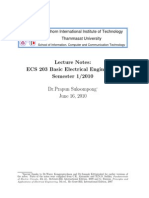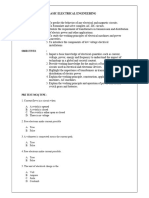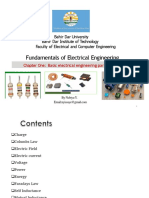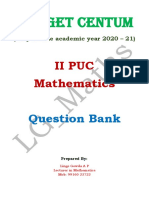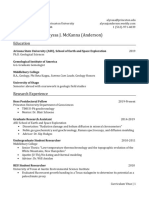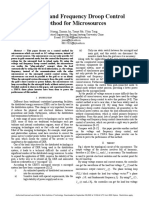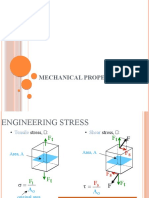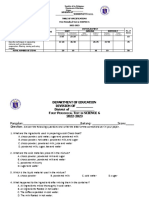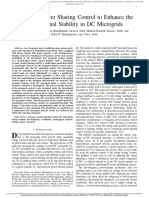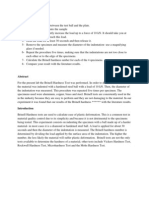Chapter 2.
Circuit Elements
Page 1
� Introduction
⚫ The behavior of an electric circuit depends on the behaviors of the
individual elements that comprise the electric circuit.
⚫ Constitutive equations
◆ Describe the behaviors of the various types of circuit elements
◆ Conventionally describe a relationship between the current and voltage of
the element – Ohm’s law
⚫ Several common types of circuit elements
◆ Resistors
◆ Independent voltage and current sources
◆ Open circuits and short circuits
◆ Voltmeters and ammeters
◆ Dependent sources
◆ Transducers
◆ Switches
Page 2
� Linear Model
⚫ Model
◆ Describes properties of a device.
◆ Can be used in pencil-and-paper calculations that will predict a circuits
comprised of actual device will operate.
⚫ Simple model vs. accurate model
◆ Simple models are easy to work with but may not be accurate.
◆ Accurate models are usually more complicated and hard to use.
⚫ Linear element vs. Nonlinear element
◆ Circuits that consist entirely of linear circuit elements are easier to analyze
than circuits that contain some nonlinear elements
⚫ Linear element satisfies
◆ Superposition
◆ Homogeneity
Page 3
� Active and Passive Circuit Elements
⚫ A passive element absorbs energy.
t
w = vi d 0
-
⚫ An active element supplies energy.
t
w = vi d 0
-
Page 4
� Resistivity & Ohm’s Law
⚫ Resistivity,
◆ The ability of a material to resist the flow of charge.
⚫ Resistivities of selected materials
Polystyrene 1 x 1018 Insulator
Silicon 2.3 x 105 Semiconductor
Copper 2.7 x 10-6 Conductor
⚫ Ohm’s law
◆ A is the cross-sectional area
◆ L is the length
◆ R is resistance (Ω)
Page 5
� Resistor
⚫ Symbol and I-V relationship v
+ _ i
v
⚫ Ohm’s law
⚫ Conductance
◆ G : Conductance in siemens (S)
Page 6
� Power Dissipation in Resistor
⚫ Power delivered to a resistor when the passive convention is used is
⚫ Energy delivered to a resistor is
t t
w = pd = i 2 Rd 0 since i 2 0
− −
◆ Resistance is passive element
⚫ Resistance is measure of an element’s ability to dissipate power
irreversibly
Page 7
� Independent Sources
⚫ Definition
◆ A source is a voltage or current generator capable of supplying energy to a
circuit
◆ An independent source is a voltage and current generator not depend on
other circuit variables
⚫ Types
◆ Voltage source ◆ Current source
Special case of Special case of
ideal voltage source ideal current source
wth v(t)=0 wth i(t)=0
Page 8
� Voltmeters and Ammeters
⚫ Ideal Ammeters act like short circuit and ideal Voltmeter acts like open
circuit
Page 9
�Voltmeters and Ammeters : Measurement
Page 10
�Voltmeters & Ammeters : Reference Direction
_ _
+ va vb +
v a= - v b
ia ib
ia= - ib
Page 11
� Dependent Sources
⚫ Definition
◆ Dependent sources model the situation in which the voltage or current of
one circuit element is proportional to the voltage or current of the second
circuit element.
⚫ Types
id id
vd = ric vd = bvc
+ id = gvc + id = dic
+ +
_
vd vd
_
_ _
Gain r b g d
Unit (V/A) (V/V) (A/V) (A/A)
< CCVS > < VCVS > < VCCS > < CCCS >
Page 12
�Dependent Sources : Example
< VCCS >
Page 13
� Transducers
⚫ Definition
◆ Transducers are devices that convert physical quantities to electrical
quantities.
⚫ Potentiometers
a=
◆ Convert position to resistance 360
⚫ Temperature sensors
◆ Convert temperature to current
Page 14
� Switches
⚫ Two distinct states
⚫ SPST (Single-Pole Single Throw)
⚫ SPDT (Single-Pole Double Throw)
Page 15





























